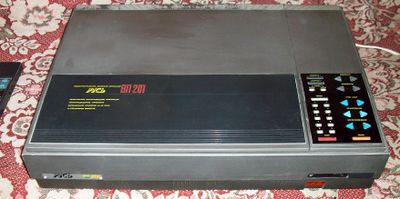Rus VP 201
Jump to navigation
Jump to search
| Release Info | |
|---|---|
| Manufacturer | Rus |
| Release Date | 1989 [1] |
| Country | Russia |
| Color Encoding System | PAL |
| Features | |
| Playable Disc Formats | LD |
| Playable LaserDisc Modes | CAV, CLV |
| Both-Side Play | None |
| CX Noise Reduction | No |
| Video Characteristics | |
| Horizontal Resolution (TVL) | |
| Video Signal-to-Noise Ratio | 41dB |
| Laser Type | Helium-Neon Tube |
| Laser Wavelength | |
| Digital Video Processor | None |
| Analog Audio Characteristics | |
| Frequency Response | 40-20,000Hz |
| Signal-to-Noise Ratio | 61dB |
| Digital Audio Characteristics | |
| Frequency Response | |
| Signal-to-Noise Ratio | |
| Power Characteristics | |
| Input Voltage | 220V |
| Power Frequency | |
| Power Consumption | 60W |
| Physical Characteristics | |
| Dimensions (W x H x D) | 520 x 113 x 362mm |
| Weight | 10kg |
| Loading Belt Part No. | |
| Accessories | |
| Remote Control | Rus DU 201 |
Clone Model Numbers/Rebadges
Manuals
Technical Data References
Other Information
Original Russian Spelling "Русь ВП-201" [1]
Rus VP-201 became the first and last mass-produced domestic model of LaserDisc players. It was produced at the State Ryazan Instrument Plant, as well as at the Yaroslavl Plant Mashpribor under the brand name Amphiton VP-201. Before the collapse of the country, both brands managed to release a total of around 500 pieces. By chance, several of these players have survived to the present day, one of them occupies an honorable place in the State Polytechnical Museum in Moscow.[2]











